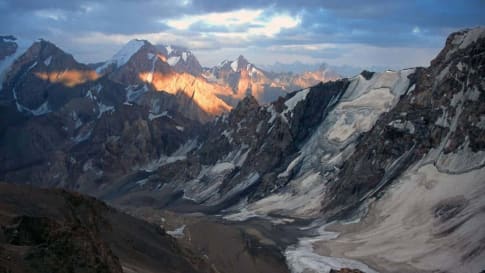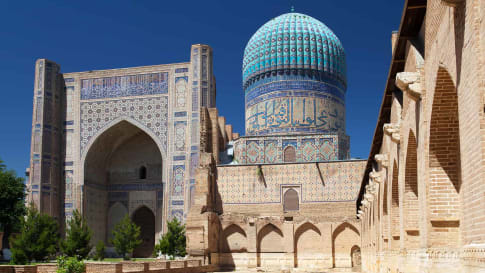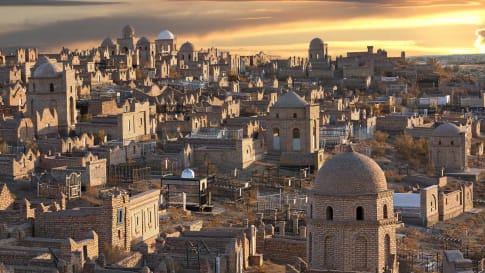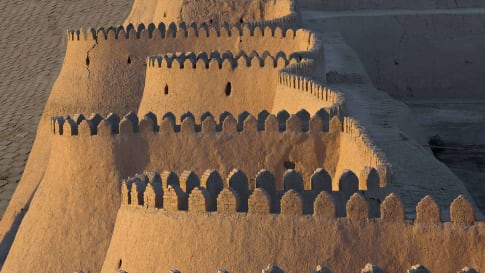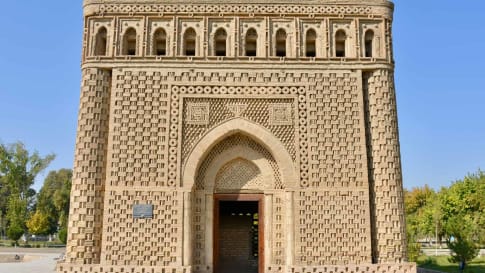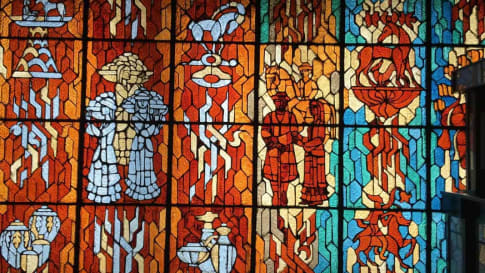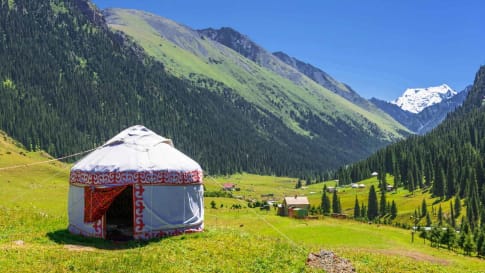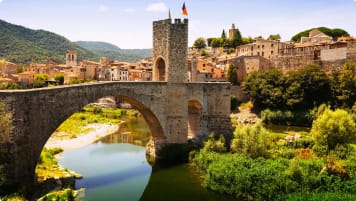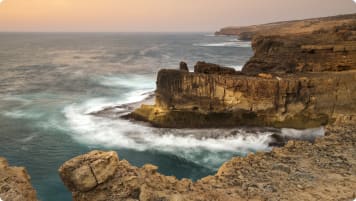The Stans Small Group Tour: Uzbekistan, Kazakhstan, Kyrgyzstan, and Turkmenistan
This journey is crafted for the adventurous traveller—whether solo or as a couple—seeking a small group tour through Central Asia. Be prepared for a variety of accommodations, scenic walking excursions, and a few full travel days. The itinerary blends stunning landscapes, a mix of ancient and modern history, as well as authentic encounters with local families and dramatically different ways of life.
From €10,774EUR

Highlights
- 1. Travel in Central Asia westward from the Tien Shan to the Karakum Desert.
- 2. In Turkmenistan visit the ancient cities of Khonye Urgench and Merv with time in and around the modernised capital, Ashgabat.
- 3. Spend a night on the shore of the Aral Sea and explore the ancient monuments of Kiva, Bukhara and Samarkand in Uzbekistan.
- 4. In Kazakhstan vistit Almaty and the natural beauty of the Kolsai Lakes.
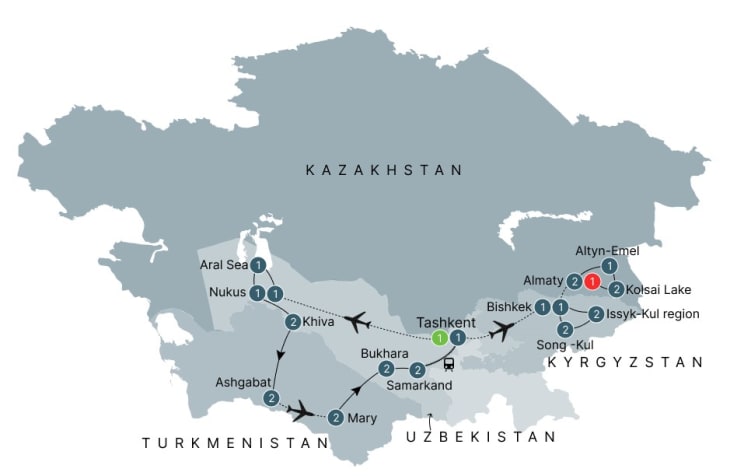
Departure Dates
| Departure Date | Price |
|---|---|
| 25 May 2025 Ends 21 June 2025 • 28 days €10,774 Twin €12,206 Single Guaranteed | Selected |
| 17 August 2025 Ends 13 September 2025 • 28 days €11,202 Twin €12,606 Single Available | |
| 24 May 2026 Ends 20 June 2026 • 28 days €11,202 Twin €12,606 Single Available | |
| 16 August 2026 Ends 12 September 2026 • 28 days €11,202 Twin €12,606 Single Available | |
| 23 May 2027 Ends 19 June 2027 • days €11,595 Twin €12,606 Single Available | |
| 15 August 2027 Ends 11 September 2027 • days €11,595 Twin €12,606 Single Available |
The Stans Small Group Tour | Visit Uzbekistan, Kazakhstan, Kyrgyzstan, Turkmenistan
This fully escorted small group educational tour to Uzbekistan, Kazakhstan, Kyrgyzstan, and Turkmenistan, or "Odyssey to the Stans," is designed for the adventurous traveller.
But the rewards will be incredible. Our small group educational program visits places off the regular travel itinerary. As such, it combines spectacular scenery, destinations on the UNESCO World Heritage list, and encounters with both ancient cities and modern history. This sightseeing tour and walking tour also features a lunch or dinner with a local family or at a local restaurant. Local guides introduce us to lifestyles and cultures that may differ dramatically from our own. Our Uzbekistan, Kazakhstan, Kyrgyzstan, Turkmenistan small group tour is thus for those who remain curious and are seeking an adventure.
Our guided tour of the Stans is packed with history. Across our journey, we listen to local stories and wonder in awe at the power and control once exerted by bygone rulers. In addition, we travel along ancient trade routes that were once part of the Silk Road. Each city and place visited enables us to learn more about its role in contemporary society.
The Stans Tour Itinerary
Uzbekistan
Our tour of Uzbekistan begins in the capital, Tashkent with a visit to the traditional Chorsu Bazaar. We then go on to explore the cities of the ancient silk road. In Samarkand we marvel at the grand Timurid architecture (i.e. built by Timur, better known in the west as Tamerlane) of Registan Square. We then explore the old town of Bukhara, a UNESCO World Heritage Site, and take in the 18th century Bolo Hauz Mosque. We also visit the walled city of Khiva, another important trading city on the great Silk Road. Khiva is home to the Kalta Minor Minaret and the Kunya fortress - with an administrative centre, law courts, and a historic mosque. Our tours to Uzbekistan also include a night camping in the atmospheric desert surrounding the Aral Sea.
Turkmenistan
Highlights of our tour of Turkmenistan include a visit to the peculiar white marble city of Ashgabat, packed with monuments both to Soviet and contemporary dictators. We also make a trip to Merv, once one of the most significant cities in the Persian Empire. Destroyed by Mongol forces in 1221, Merv is today a fascinating archaeological site.
Kyrgyzstan
In Kyrgyzstan we make the most of the natural beauty of this remote country, over 80% of which is covered by mountain ranges. Near beautiful Son-Kul Lake, we stay for the night in a traditional yurt. The yurt is a testament to the nomadic past of the Kyrgyz people. Our trip also takes in the remnants of ancient civilisations at the town of Balasagun and the Petroglyphs Gallery of Cholpon-Ata. Finally, our tour of Kyrgyzstan ends in Bishkek, where we take a city tour and visit local markets.
Kazakhstan
In Kazakhstan we begin our tour in Almaty. The Soviet impact remains in this city of Almaty and is on display in many forms. The capital of Kazakhstan until 1997, Almaty is a leafy city with a contemporary vibe. Outside Almaty, we take in Kazakhstan's striking natural beauty: the Charyn Canyon (often called the 'little brother' of America's Grand Canyon), and the pristine blue lakes of the Kolsai Lake System.
In addition, we are offering an optional 7-day extension to Tajikistan, the last of the former Soviet Block countries. Though rarely visited by travellers, Tajikistan has a lot to offer, including beautiful mountain scenery, alpine lakes and the generous hospitality of the Tajik people.
This fully escorted educational tour is perfect for the active single traveller or couple with an enquiring mind. It will deepen our understanding and appreciation of the history and culture of these ancient lands and their modern incarnation.
You can find more information of each country visited with our country profiles: Uzbekistan, Kazakhstan, Kyrgyzstan, Turkmenistan. For more details on this tour, click the ‘Top 5’ or ‘Itinerary’ buttons above! If you’re keen to experience this tour, please call or send an email. Or, to book, simply fill in the form on the right hand side of this page.
Gallery
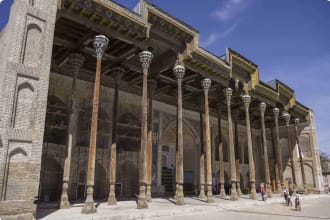
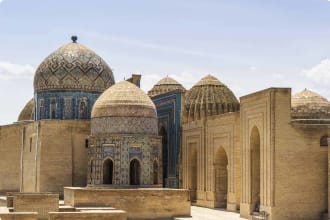
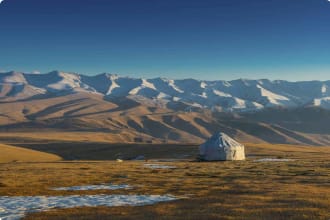
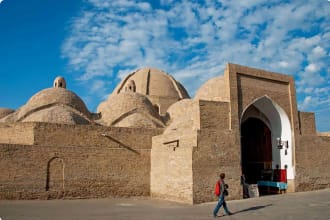
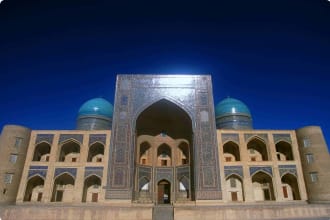
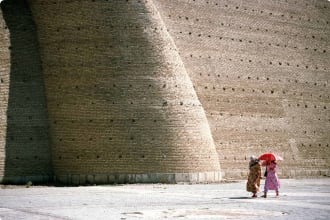
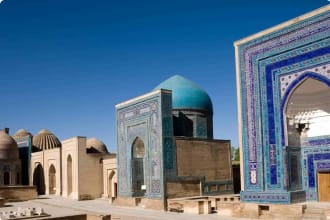
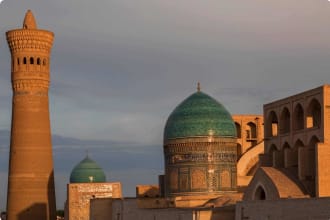
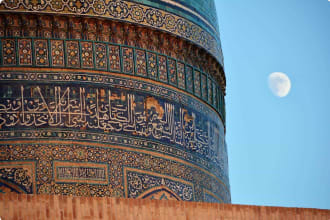
Itinerary
28 days
Day 1: Tashkent (Uzbekistan)
Accommodation: 1 nights at Inspira Hotel or similar.
Upon arrival, make your own way to the hotel. The first group meeting and tour introduction will be at 6:00 pm in the hotel lobby and this will be followed by dinner.
Day 2: Tashkent - Nukus
Accommodation: 1 night at Pana Hotel or similar.
We start our sightseeing tour of the city. Our first stop will be the Museum of History, it opened in 2003, and it is the biggest history museum in the republic, containing departments of Ancient History (with 2 exchibitions of Buddha), Middle Ages, Islam in Uzbekistan, New History (19-20 century), and Modern Uzbekistan. We will also visit Mustakillik Square (formerly “Red Square”), which is the main square of the Tashkent with a monument to victims of WWII. We will see Navoi Theatre, a building which has its own personality. Planning and construction began in 1940 and Japanese prisoners of war completed construction in 1947.
We stop for lunch at a local restaurant and later continue with our tour. We visit Chorsu bazaar, the main oriental market in Tashkent, then make our way to Kukeldash Madrassah (16th century) which has a domed courtyard and now services as an Islamic school and beside it is the tiny 15th century Juma Mosque. Our next stop will be Tashkent Metro stations. Construction began in 1972 and 5 years later the first train rolled out. Some people say that Tashkent metro has some of the most beautiful metro stationsin the world. Our tour will end with a visit to Amir Temur Square, the central park with a statue of Amir Temur on horseback, also known as “Broadway.”
Dinner will be at local restaurant followed by a transfer to the airport for our flight to Nukus.
Day 3: Nukus - Aral Sea
Accommodation: 1 night tented camp.
We have an early breakfast for a 7:00 am start on our 500 kilometre drive to the shores of the Aral Sea, with stops at Kungrad city and across Plato Ustyurt. Kungrad was the gate town of ancient Khorezm, it was inhabited by Sako-Massaget tribes and today the city is within an independent republic of Uzbekistan, Karakalpakstan. Plato Ustyurt is a stony desert plain with an elevation average of 150 metres above sea level, west of the Amu Darya delta. It is rich in archaeological sites from the Neolithic period, and contains remains from the Scythians, the Mongols, and other ancient nations. Locally there was an ancient town Sharh-i-Wazir, a caravanserai of Beleuli and the Allan fortress, and it served as a stopping place for caravans between Khiva and the Volga. Nowadays it is possible to see grave sites and a number of ancient necropolis scattered about this plain.
We have a boxed lunch with a planned sea side arrival early evening. The Aral Sea is the second biggest “lake” in Asia, receiving water from 2 long rivers, the Amu Darya and Syr Darya, that originate in the mountains of eastern Central Asia. Today the Aral Sea is much smaller than what it was before the poorly-planned Soviet-initiated irrigation projects began, but this location is still considered by many the most beautiful and mysterious place in the whole of Asia.
We enjoy a dinner outside and sleep overnight in tents.
Day 4: Aral Sea - Muynak - Nukus
Accommodation: 1 night at Pana Hotel or similar.
Our return journey begins after breakfast, we drive for about 1.5 hours to Muynak. Muynak is the city that once supplied all Central Asia with fish products and was located on the shore of the Aral Sea. Now it is deserted with the Aral Sea shores 150 kilometres away, and we see the “Cemetery of ships,” reminding us that Muyna was one of the biggest ports in Uzbekistan and that people traveled to and from here by river. We have lunch in Muynak before continuing our drive to Nukus.
Dinner will be at the hotel this evening.
Day 5: Nukus - Khiva via Toprak Kala, Ayaz Kala
Accommodation: 2 nights at Farovon Hotel or similar.
In the morning we visit enjoy a short visit to the State Museum of Art (named after I.V.Savitsky). We then depart by road to Khiva (180 km – 4 hours travel) via Kalas. We stop en-route to visit Toprak and Ayaz Kala and arrive in Khiva in the evening.
Khiva is on the Amu-Darya, the longest of the 2 rivers that run east to west across Central Asia, and so has a long history of agriculture in an otherwise arid environment. It was also a trading post and on a minor branch of the Silk Road trading route. Following Tamerlane’s (Timur) plundering and destructive campaigns of the late 1300s, Khiva became capital of Khorezm khanate. Its inner city is packed with many religious buildings and buildings from past rulers. On arrival we check in at our hotel and have a short break before dinner.
Day 6: Khiva
Accommodation: Farovon Hotel or similar.
Today we spend the exploring the Khiva, a town established over 2500 years ago, and an important stop on the Silk Road.
We visit the main sights of Khiva including Kalta Minor Minaret, the Kunya ark fortress with administrative buildings, gunpowder works, law courts, Juma Mosque, Islam Khodja Minaret, Pakhlavan Makhmud complex, the most remarkable architecture memorial complex in Khiva with unique tiles, Museum of Mennoniten, and Ak-Sheikh Baba Observation platform.
We will have lunch at a local home with traditional Khorezmian meal.
Day 7: Khiva - Dashoguz border - Ashgabat
Accommodation: 2 nights at Sport Hotel or similar.
Today we drive to the border between Uzbekistan and Turkmenistan and cross it via Dashoguz Border Pass. After border formalities we continue our journey and stop to visit Koneurgench, the capital of Khorezmshahs, a UNESCO World Heritage listed site. Our sightseeing in Old Urgench includes: visit Portal of Caravansaray, Mamun Minaret, II Arslan Mausoleum, Sultan Tekesh Mausoleum, Academy of Horezm, Kutlug Timur Minaret and Turabek Hanum Mausoleum.
We pause for lunch at local restaurant then continue our drive to Dashoguz.
In the evening we take a flight from Dashoguz to Ashgabat. Upon arrival in Ashgabat transfer to the restaurant to have dinner and later to our hotel.
Day 8: Ashgabat
Accommodation: Sport Hotel or similar.
We spend our day exploring the city of Ashgabat, including a visit to the memorial complex “Halk Hakydasy”. We also take a drive to visit Nisa fortress – the Sanctuary of Parthian Kings, a UNESCO World Heritage Site since 2007. Nisa is described as one of the first capitals of the Parthians, founded by Arsaces I (reigned c. 250 BC – 211BC), and is reputedly the royal necropolis of the Parthian Kings, although it has neither been established that the fortress at Nisa was a royal residence or a mausoleum. We then continue visit Turkmenbashy Ruhy Mosque in Kipchak (the largest mosque in Central Asia), followed by lunch at local restaurant.
Later, we transfer to the state hippodrome to view with Turkmen Akhalteke horses and enjoy a horse show. In the evening, we have dinner at a local restaurant. After dinner, we will enjoy a drive around the city’s main avenues, including a stop near Palace of Happiness to have a look around its colorful views in night lights.
Day 9: Ashgabat - Mary
Accommodation: 2 nights at Mary Hotel or similar.
After breakfast we continue with our visits of the city, including the Museum of Turkmen Carpets (Note: closed on Sundays & during National Holidays. Open on Saturdays until 1:00PM), which houses the largest collection of Turkmen carpets and has a rich collection, from medieval through to the 20th century. Here we will also see one of the biggest handmade carpets in the world with the Guinness Book Certificate. Later we transfer to our hotel with some time to freshen up before lunch at a local restaurant.
In the afternoon we visit the Cable Way lifted Mountain Observing Center known as “Asma Ýoly,” located close to Ashgabat on Kopetdag Mountains. We will also see the Monument of Constitution. Opened in May 2011, it is the tallest building in Turkmenistan. We will visit “Alem” Culture & Recreation Center, which has the biggest indoor Ferris Wheel in the Guinness Book, as well as the Arch of Neutrality, a famous rocket and tripod-style built building symbolizing neutral status of Turkmenistan, which was rebuilt and opened late in 2011. We will also see Monuments of Independency located in the Park of Independency along the hundreds of fountains and statues.
Late afternoon we transfer to the airport for our flight to Mary, upon arrival we transfer to the hotel for check-in followed by dinner at local restaurant.
Day 10: Mary
Accommodation: Mary Hotel or similar
After breakfast we start our full day touring, starting at the World Heritage listed site of Old Mary (Merv), followed by time back in Mary where we will spend the night.
Merv was a most significant ancient capital in the Persian Empire, but the population was decimated by Mongol forces in 1221. It has seen many changes in its dominant population over time, and we can thank the Russian, Turkish, and British archaeologists for the excavations we see today. Merv, which has an honour title of Mary Shahu Jahan (King of the World), was for about 300 years the biggest city in Central Asia. For 8 years it was capital of the World Islamic Khalifat. The listed sites of monuments we see include Gyz Gala & Oglan Gala from the 6th and 7th century, the Complex of Askhabs 8th to 14th century, Gyaur Gala 4th century BC, Buddist Stupa & Monastery 4th to 6th century, Beni Makhan Mosque- first Mosque build in Central Asia during the 7th century, Erk Gala 6th century BC, Soltan Gala 11th century, and Soltan Sanjar Mausoleum and Ibn Zeid Mausoleum, both from 12th century. We then drive back to Mary and check in to our hotel, followed by lunch at a local restaurant.
In the afternoon we visit the Local United Museum of History and Ethnography, and see the Flora & Fauna of Mary and the Regional Orthodox Church built by Russians at the end of 9th century. We will take a walking tour within the central part of Mary City, which has The Regional Mosque of Mary Providence, The Central Theater of Mary, The Convention & Conference Center “Ruhiyet Koshgi,” Central Park, and the Monument of Mollanepes, the National Classic Poet who lived in Mary in the 18th century. We conclude our day’s activities with a dinner at a local restaurant tonight.
Day 11: Mary - Farab border - Bukhara
Accommodation: 2 nights at Omar Khayam Hotel or similar
Today we drive from Mary to the border between Turkmenistan and Uzbekistan and cross it via Farab Border Pass. We’ll travel 247 km. En route we’ll have a lunch at local restaurant.
We’ll also stop at the Turkmenabat city on our way to Farab border, located about 60 km / 40min drive.
Upon arrival at the border, we’ll be assisted by our local guide and complete the border crossing formalities. We then cross into Uzbekistan and continue our drive to Bukhara, arriving at our hotel in time for dinner.
Day 12: Bukhara
Accommodation: Omar Khayam Hotel or similar
Today we have a full morning sightseeing, with visits including the Poikalon ensemble in the center of old Bukhara, which includes the central mosque Masjidi Kalon, Miri Arab madrassah, and the most impressive Kalyan minaret. We then visit the Trading Domes, Magoki Attori, and the Nodir Devon Begi madrassah.
Lunch will be at a local restaurant, and the afternoon is at leisure to rest or explore the city on your own. The group meets again for dinner at local restaurant.
Day 13: Bukhara - Samarkand
Accommodation: 2 nights at Royal Terrace Hotel or similar
In the morning, we continue our sightseeing, most of which is in the inner city of Bukhara, a declared World Heritage Site. We’ll visit Samanid’s mausoleum, a 9th-10th century building – the first in Central Asia to be built from baked bricks. We will also visit Chashma Ayub Mausoleum and the Bolo Khauz Mosque, set up in 1712. We will explore the Ark Fortress (6th–19th centuries) which is like a town completed with the emirs house, mosques, mint, government institutes, store rooms, and more.
After lunch we depart Bukhara and journey to Samarkand (300km – 5 hours travel). On arrival we will check in to our hotel and then make our way to a local restaurant for dinner.
Day 14: Samarkand
Accommodation: Royal Terrace Hotel or similar
Samarkand, home of World Heritage listed monuments and archaeological sites offers plenty to explore. We begin our touring of these with the excavated quadrant of Ulugbek Observatory, then visit Afrasiab Hill, a hill-fort named after legendary king of Turan. In Afrasiab Museum we will see each hall of the museum containing exhibits of certain periods in the history of the location.
After lunch at a local restaurant we continue to see 4 other sites, including Bibi Khanum mosque (9th century), where architects, craftsmen, and painters were involved in a 5 year build. We travel on to Shahi Zinda mausoleum, a most interesting set of 20 buildings from the 9th century to the 15th century, followed by a visit to Siab Bazaar, the main bazaar of Samarkand on the crossroad of ancient trading routes.
Dinner tonight will be at national house with Plov preparation master class.
Day 15: Samarkand - Tashkent
Accommodation: 1 nights at Inspira Hotel or similar.
After breakfast, we continue our sightseeing of Samarkand visiting Gur Amir mausoleum, a Timurids dynastic burial vault, culminating with the Grand Registan visit, a square which is lined on 3 sides by the Madrassah of Ulugbek, Sher Dor, and Tillya Kari. We’ll pause at a local restaurant for lunch.
Later we visit “Konigil Meros” Water Mill and Paper Factory, which still produces handmade Samarkand Paper using the ancient recipe from mulberry tree bark. We can watch the process of production and have a hands-on trial. We will also visit a silk carpet factory “Hudjum.”
Later we will transfer to the station to board the high-speed train “Afrosiab” to Tashkent. Upon arrival we’ll be met and transferred to our hotel. Dinner this evening will be at a local restaurant.
Day 16: Tashkent - Bishkek
Accommodation: Plaza Hotel or similar.
In the morning we enjoy more sightseeing in Tashkent followed by lunch at a local restaurant.
We’ll transfer to to the airport in the afternon for our flight to Bishkek – capital of Kyrgyzstan.
On arrival we’ll meet with our Kyrgyz guide at the airport and transfer to the hotel. We’ll have some time to freshen up before dinner.
Day 17: Bishkek - Issyk Kul (Cholpon Ata)
Accommodation: 2 nights at Karven 4 Seasons Hotel or similar.
In morning we drive to Issyk-Kul Lake, which is called pearl of Kyrgyzstan. On the way we will visit the Burana tower-museum, which is located in what was the centre of the ancient town of Balasagun. Near the tower is a museum with artefacts inside and out covering an area of 36 hectares. There are stone statue gravestones of nomadic Turkic people of the 6th to 10th centuries, petroglyphs from the 2nd century B.C. to the 10th century A.D., stone agricultural implements, and other monuments to be found outside. Lunch will be with a Kyrgyz family living near Burana Tower.
In the afternoon we continue by road toward Issyk-Kul lake via Boom Pass (250 km). Boom canyon is a very beautiful place, full of high mountains, green pines, and a sparkling river. Issyk-Kul lake occupies the central part of the valley created by a circle of the Terskey and Kungey Ala-Too mountain ranges. Issyk-Kul lake is the largest in the Tien-Shan mountains and is unique in that dozens of rivers and streams flow into it, yet none flow out. Accommodation and dinner will be in comfortable Issyk-Kul resort.
Day 18: Cholpon-Ata - Karakol - Kaji Say
Accommodation: Karven 4 Seasons Hotel or similar.
On our journey around the northern and eastern sides of the lake to Karakol we stop to see an open-air museum, the Petroglyphs Gallery of Cholpon-Ata, with rock figures created by ancient artists in the 4th century BC. The scenes vary with images of animals, especially of mountain goats with curved spiraling horns. All the figures were engraved in profile and there are grounds for thinking that these images are some kind of an open cult temple, a place where ancient nomadic people worshiped.
Lunch will be in a local café in Karakol town with time after lunch allocated for a sightseeing tour in Karakol to see a Chinese built mosque that looks like a Buddhist temple, but was built in 1907 for the Dungan (Muslim people of Chinese origin). We also visit the local Cathedral for Orthodox worshippers, a church showing the past presence of Russians in the community, and finally a memorial complex of grave, museum, and apple garden for Nikolai Przewalski, a mid-1800s Russian explorer/geographer and the first westerner to observe the Przewalski horse.
We then return to Cholpon-Ata. Accommodation and dinner will be in comfortable Issyk-Kul resort.
Day 19: Kaji-Say - Son-Kul
Accommodation: 2 nights in yurts - shared accommodation
Today we transfer to the beautiful valley of Son-Kul lake and have lunch in Kochkor village, a hub for the surrounding Kochkor valley. The local Kyrgyz are hospitable and affable people working in agriculture and traditional Kyrgyz crafts. Here we will visit a felt carpet making display and handicrafts shop along with an excursion to see local needlewoman. We then continue to Son-Kul (also spelled Song Kol) lake. The scene that greets you in Son-Kul is surprising. The wide, brilliant, steel- coloured expanse of the water appears majestic, quiet, and transparent.
We have a traditional nomad dinner and tonight we are accommodated in yurts at the bank of the lake.
A yurt is more sophisticated than a tent, but still relatively basic accommodation. The yurt camps do not have shower facilities, but will have access to water and a private area for washing. The toilets are “outhouse” style, at a distance from the yurts – please ensure you bring a torch for night-time visits (head-torches are particularly useful!). Single and twin share travelers will need to share for the following 2 nights as yurts are limited and take 3 to 4 people each. (Note: no single room option available, the group will be accommodated in a sharing bases for 2 nights)
Day 20: Son-Kul
Accommodation: Yurts
We will be greeted by the beautiful lake with its majestic and peaceful surrounds. We’ll enjoy a visit to the shepherds’ yurts before ascending to one of nearby hills to see a stunning panoramic view of the lake, described as being one of the loveliest spots in central Kyrgyzstan. We will also have the opportunity for some horse riding.
Day 21: Son-Kul - Bishkek
Accommodation: 1 nights at Plaza Hotel or similar.
After breakfast we transfer to Bishkek via Kalmak-Ashuu Pass. Lunch will be on the way or in Bishkek upon arrival.
After lunch we will enjoy some free time and the group meets again for dinner at the hotel.
Day 22: Bishkek - Almaty
Accommodation: 2 nights at Kazzhol Hotel or similar.
Bishkek is a relatively young city with quite a checkered history that started as a garrison town and was only given its Kyrgyz name in 1991. It has quite beautiful gardens and tree plantings, including 2 century-old oak trees near the National Museum, one of the places visited in our morning schedule. We also visit the White House, a palace made of white marble housing the Kyrgyz government, the president’s office and the republic parliament. Behind the White House is Panfilov Park with nice walkways and water features. We then visit Freedom Avenue before lunch in a local cafe.
After lunch we visit a traditional Asian Bazaar with some free time to enjoy the markets and shop for local crafts if you wish.
Later in the afternoon we transfer to the airport for our evening flight to Almaty – capital of Kazakhstan. On arrival we will be met and transferred to our hotel, followed by dinner.
Day 23: Almaty
Accommodation: Kazzhol Hotel or similar.
Today we have a full day of visits in Almaty, including the 28 Panfilov’s guardsmen park, the Cathedral Church of St. Nicholas, the Museum of National Musical Instruments, and the National Museum and Republic Square.
Lunch will be in Almaty before we drive up and out of the city to Medeo skating rink. This is the largest rink in the world and is set in a picturesque gorge some 15 kilometres from Almaty. We will enjoy dinner in a restaurant with a traditional Kazakh menu before returning to our hotel.
Day 24: Almaty - Altyn-Emel
Accommodation: 1 night Altyn-Emel Guesthouse or similar.
After breakfast we transfer over to Altyn-Emel National Park via Kapchagay and Chengeldy village. The park is on the north bank of the Ili River and was created in 1996. The name “Altyn Emel” has a Mongolian origin, meaning “a gold saddle.” The park is a unique desert-mountain complex located on a branch of the ancient Silk Road. In the park we will see Bronze Age petroglyphs representing hunting, wild animals and pets, rituals, and deities with sun faces.
After lunch we visit the stone column “Oshaktas” that are situated nearby the Kalkan Mountains. We also visit Singing Barchans, crescent-shaped sand dunes that “sing” with the wind. En route we stop near the sacred place of The Spring of Chokmor Valihanov. In the evening we will head to our guest house. Depending on the size of our group we’ll be split between 2 places near each other.
Dinner will be at our guestouse this evening.
Day 25: Altyn-Emel - Kolsai Lakes
Accommodation: 2 nights at local family house accommodation.
After breakfast we transfer to Charyn Canyon and on the way visit the 700-year-old tree Aulie-Agash, a magic tree in settlement of Kieli-Agash. Charyn Canyon, often referred to as the little brother of the Grand Canyon, is being carved by the rapidly flowing Charyn River into a flat and barren steppe. Through the passage of time it has weathered all sorts of wonderful and colourful rock formations. After the canyon we continue our way to Kolsai Lakes (150 km) for dinner and accommodation in cottages.
Day 26: Kolsai Lakes
Accommodation: Local family house accommodation.
Following breakfast we have a half day walking excursion along part of the Kolsai Lake system. The Kolsai lakes are located among amazing mountain ridges with naturally blue water and fir trees that are growing in the water. These lakes are named the pearls of the North Tian-Shan and the lowest lake, at 1,818 metres, stretches for 1 kilometre. The middle Kolsai Lake (2,252 m), the largest and the most beautiful, is 5 kilometres from the first lake. The highest lake, Kolsai (inaccessible for our tour), is 4 kilometres further and 600 metres higher up.
After lunch we will enjoy some free time and the group meets again for dinner at the accommodation.
Day 27: Kolsai Lakes - Almaty
Accommodation: 1 night at Kazzhol Hotel or similar.
Today we have some free time before our transfer back to Almaty.
Dinner this evening is at our hotel.
Day 28: Almaty
The tour ends today after breakfast.
Travellers taking the extension into Tajikistan will have a free day today, until meeting the rest of the group for a welcome dinner in the evening and a flight out to Dushanbe on the following day.
Tour Notes
- Group size is limited to a maximum of 16 participants.
Includes / Excludes
What’s included in our Tour
- 27 nights of accommodation.
- Services of an Odyssey Tour Leader.
- Full board while on tour (starting with Dinner on Day 1)
- Transport and field trips as indicated.
- All internal flights and taxes.
- Applicable entry fees and services of local guides.
- Service charges and gratuities.
- Detailed tour information booklet.
What’s not included in our Tour
- Comprehensive travel insurance.
- International return airfares including taxes.
- Items of a personal nature.
- Visas for entry, if required.
Participants must be in excellent health, extremely mobile and live an active lifestyle. Program activities may include up to 6 hours of continuous strenuous, moderate-to-fast paced activities per day on varied terrain.
Book now
Make it a private tour
Easing your journey
Crossing international borders with restrictions
The list of requirements to travel internationally has changed and will continue to change for several years. Odyssey is here to assist you in managing your way through these requirements:
For more information see our Crossing international borders with restrictions page.
Book With Confidence
If less than 30 days before your tour starts you are unable to travel as a result of Government travel restrictions, Odyssey Traveller will assist you with a date change, provide you with a credit or process a refund for your booking less any non-recoverable costs.
See Terms and conditions for details.
Peace of Mind Travel
The safety of our travellers, tour leader, local guide and support staff has always been our top priority and with the new guidelines for public health and safety for keeping safe for destinations around the world, we’ve developed our plan to give you peace of mind when travelling with us.
See Peace of Mind Travel for details.
Reading List Download PDF
The Great Game: The Struggle for Empire in Central Asia
Peter Hopkirk
Peter Hopkirk's spellbinding account of the great imperial struggle for supremacy in Central Asoa has been hailed as essential reading with that era's legacy playing itself out today.
The Great Game between Victorian Britain and Tsarist Russia was fought across desolate terrain from the Caucasus to China, over the lonely passes of the Parmirs and Karakorams, in the blazing Kerman and Helmund deserts, and through the caravan towns of the old Silk Road-both powers scrambling to control access to the riches of India and the East. When play first began, the frontiers of Russia and British India lay 2000 miles apart; by the end, this distance had shrunk to twenty miles at some points. Now, in the vacuum left by the disintegration of the Soviet Union, there is once again talk of Russian soldiers "dipping their toes in the Indian Ocean."
The Washington Post has said that "every story Peter Hopkirk touches is totally engrossing." In this gripping narrative he recounts a breathtaking tale of espionage and treachery through the actual experiences of its colorful characters. Based on meticulous scholarship and on-the-spot research, this is the history at the core of today's geopolitics.
The Hidden War: A Russian Journalist's Account of the Soviet War in Afghanistan
Artyom Borovik
Until his death in 2000, Artyom Borovik was considered one of the preeminent journalists in Russia. With The Hidden War he provided the world its first glimpse inside the Soviet military machine, capturing the soldiers' terror, helplessness, and despair at waging war in a foreign land against an unseen enemy for unclear purposes. When first published, Borovik's groundbreaking revelations exposed the weaknesses beneath the Soviet Union's aura of military might, creating an enormous controversy both in Russia and around the world. A vital and fascinating portrait of the Soviet empire at the twilight of its power, this is a book that still resonates today. "An honest and graphic account of individual and general disillusionment during the very worst kind of war." -Christopher Hitchens, New York Newsday; "Alternately fascinating and horrific.... A fascinating look at the life and death of Soviet soldiers." -- Bill Wallace, San Francisco Chronicle; "I have read no other account of the war in Afghanistan equal to this ... this is literature." -- Graham Greene
Inside Central Asia: A Political and Cultural History of Uzbekistan, Turkmenistan, Kazakhstan, Kyrgyz stan, Tajikistan, Turkey, and Iran
Dilip Hiro
The former Soviet republics of Central Asia comprise a sprawling, politically pivotal, densely populated, and richly cultured area of the world.
In this comprehensive new treatment, renowned political writer and historian Dilip Hiro places the politics, peoples, and cultural background of this critical region firmly into the context of current international focus.
"For those who still get their "-stans" mixed up, Hiro's book provides a detailed and nuanced overview of the region of central Asia. He explains the ethnic tensions, religious intolerance and struggle for political identity in the lands caught between two behemoths the splintered Soviet empire and the rising Chinese one."
-Financial Times, Best Books of 2009
"Readers acquainted with Mr.Hiro's prolific writing about Asia and the Islamic world will be unsurprised to learn that Inside Central Asia is a conscientious guide to the region, full of dependable history-telling and analysis."
-The Economist
"Hiro's account provides a fast-moving and well-sourced genealogy of the Central Asian republics' political and economic trajectories, focusing on the post-Stalinist period up to the present day. It is unlikely that more comprehensive analysis of this period in Central Asia has been written, and it serves as a valuable update to Hiro¦s earlier Between Marx and Muhammad: the Changing Face of Central Asia."
-Issac Scarborough, n+1
Making Uzbekistan: Nation, Empire, and Revolution in the Early USSR
Adeeb Khalid
In Making Uzbekistan, Adeeb Khalid chronicles the tumultuous history of Central Asia in the age of the Russian revolution. Traumatic upheavals―war, economic collapse, famine―transformed local society and brought new groups to positions of power and authority in Central Asia, just as the new revolutionary state began to create new institutions that redefined the nature of power in the region. This was also a time of hope and ambition in which local actors seized upon the opportunity presented by the revolution to reshape their society. As the intertwined passions of nation and revolution reconfigured the imaginations of Central Asia's intellectuals, the region was remade into national republics, of which Uzbekistan was of central importance.
Making use of archival sources from Uzbekistan and Russia as well as the Uzbek- and Tajik-language press and belles lettres of the period, Khalid provides the first coherent account of the political history of the 1920s in Uzbekistan. He explores the complex interaction between Uzbek intellectuals, local Bolsheviks, and Moscow to sketch out the flux of the situation in early-Soviet Central Asia. His focus on the Uzbek intelligentsia allows him to recast our understanding of Soviet nationalities policies. Uzbekistan, he argues, was not a creation of Soviet policies, but a project of the Muslim intelligentsia that emerged in the Soviet context through the interstices of the complex politics of the period. The energies unleashed by the revolution also made possible the golden age of modern culture, as authors experimented with new literary forms and the modern Uzbek language took shape. Making Uzbekistan introduces key texts from this period and argues that what the decade witnessed was nothing short of a cultural revolution.
Uzbekistan: Heirs to the Silk Road
Johannes Kalter
From the time of the Silk Road's rediscovery by European pioneers and travellers in the 19th century, the fascination of this famous route has never been lost. From the second century BC this 7000 kilometre, wickerwork pattern of traders' roads linked China and the Roman Empire. It served the trade of luxury goods, notably silk, and stimulated the spread of ideas about religion, culture and art. The young republic of Uzbekistan, with its ancient urban cultural centres of Bukhara, Chiwa and Samarkand is the heartland of the Silk Road. The artistic and cultural history of the region, from the fourth century BC until the most recent past, is represented here in four main sections; Transoxania from the fourth century BC to the eighth century AD; Central Asia as a centre of Islamic conquest in the eighth century until the fall of the Timurian empire at the beginning of the 16th century; Turkestan from the 16th century up to the beginnings of the 20th century, and Usbekistan from the Russian conquest to the establishment of sovereignty. There are also sections on architecture, books, Islamic arts and crafts and the widespread wealth of textiles of the region. The cultural history of this region is illustrated here with pictures of archaeological finds and ethnographical objects from European and Uzbeki museums and private collections, many available for the first time.
Tajikistan: A Political and Social History
Kirill Nourzhanov
This book is a historical study of the Tajiks in Central Asia from the ancient times to the post-Soviet period. For millennia, these descendants of the original Aryan settlers were part of many different empires set up by Greek, Arab, Turkic and Russian invaders, as well as their own, most notably during the Middle Ages. The emergence of the modern state of Tajikistan began after 1917 under Soviet rule, and culminated in the promulgation of independence from the moribund USSR in 1991. In the subsequent civil war that raged between 1992 and 1997, Tajikistan came close to becoming a failed state. The legacy of that internal conflict remains critical to understanding politics in Tajikistan a generation later. Exploring the patterns of ethnic identity and the exigencies of state formation, the book argues that despite a strong sense of belonging underpinned by shared history, mythology and cultural traits, the Tajiks have not succeeded in forming a consolidated nation. The politics of the Russian colonial administration, the national-territorial delimitation under Stalin, and the Soviet strategy of socio-economic modernisation contributed to the preservation and reification of sub-ethnic cleavages and regional identities. The book demonstrates the impact of region-based elite clans on Tajikistan’s political trajectory in the twilight years of the Soviet era, and identifies objective and subjective factors that led to the civil war. It concludes with a survey of the process of national reconciliation after 1997, and the formal and informal political actors, including Islamist groups, who compete for influence in Tajik society
The Silk Road - Central Asia, Afghanistan and Iran: A Travel Companion
Jonathan Tucker
Stretching from the ancient Chinese capital of Xian across the expanses of Central Asia to Rome, the Silk Road was, for 2,000 years, a vibrant network of arteries that carried the lifeblood of nations across the world. Along a multitude of routes everything was exchanged: exotic goods, art, knowledge, religion, philosophy, disease and war. From the East came silk, tea, jade, paper, porcelain, spices and Buddhism; from the West, horses, weapons, lions, precious stones and cotton. From its earliest beginnings in the days of Alexander the Great and the Han Dynasty, the Silk Road expanded and evolved, reaching its peak under the Tang and Byzantine empires and gradually crumbling along with the decline of the Mongol empire. In this beautifully-illustrated book, which covers the Central Asian section of the Silk Road - from Lake Issy Kul through Tashkent, Samarkand, Bukhara, the Kyzyl Kum Desert, Khiva and Merv to Herat, Kabul and Iran - Jonathan Tucker uses traveller’s anecdotes and a wealth of literary and historical sources to celebrate the cultural heritage of the countries that lie along the Silk Road and illuminate the lives of those who once travelled through the very heart of the world.
China's Asian Dream: Empire Building along the New Silk Road
Tom Miller
"China", Napoleon once remarked, "is a sleeping lion. Let her sleep, for when she wakes she will shake the world." In 2014, President Xi Jinping triumphantly declared the lion had awakened. Under his leadership, China is pursuing a dream to restore its historical position as the dominant power in Asia.
From the Mekong River Basin to the Central Asian steppe, China is flexing its economic muscles for strategic ends. By setting up new regional financial institutions, Beijing is challenging the post-World War II order established under the watchful eye of Washington. And by funding and building roads, railways, ports and power lines—a New Silk Road across Eurasia and through the South China Sea and Indian Ocean—China aims to draw its neighbours ever tighter into its embrace.
Combining a geopolitical overview with on-the-ground reportage from a dozen countries, China’s Asian Dream offers a fresh perspective on the rise of China’ and what it means for the future of Asia?
The Silk Road in World History
Xinru Liu
The Silk Road was the contemporary name for a complex of ancient trade routes linking East Asia with Central Asia, South Asia, and the Mediterranean world. This network of exchange emerged along the borders between agricultural China and the steppe nomads during the Han Dynasty (206 B.C.E.-220 C.E.), in consequence of the inter-dependence and the conflicts of these two distinctive societies. In their quest for horses, fragrances, spices, gems, glassware, and other exotics from the lands to their west, the Han Empire extended its dominion over the oases around the Takla Makan Desert and sent silk all the way to the Mediterranean, either through the land routes leading to the caravan city of Palmyra in Syria desert, or by way of northwest India, the Arabian Sea and the Red Sea, landing at Alexandria. The Silk Road survived the turmoil of the demise of the Han and Roman Empires, reached its golden age during the early middle age, when the Byzantine Empire and the Tang Empire became centres of silk culture and established the models for high culture of the Eurasian world. The coming of Islam extended silk culture to an even larger area and paved the way for an expanded market for textiles and other commodities. By the 11th century, however, the Silk Road was in decline because of intense competition from the sea routes of the Indian Ocean. Using supply and demand as the framework for analysing the formation and development of the Silk Road, the book examines the dynamics of the interactions of the nomadic pastoralists with sedentary agriculturalists, and the spread of new ideas, religions, and values into the world of commerce, thus illustrating the cultural forces underlying material transactions. This effort at tracing the interconnections of the diverse participants in the transcontinental Silk Road exchange will demonstrate that the world had been linked through economic and ideological forces long before the modern era.
The Stans Small Group Tour: Uzbekistan, Kazakhstan, Kyrgyzstan, and Turkmenistan

